Pontarddulais is a town in the City and County of Swansea, situated ten miles north west of Swansea city centre. It was a hamlet for centuries, straddling the River Loughor, it was an important crossing point between Glamorgan and Carmarthen. This bridge gained fame during the 1843 Rebecca Riots when rioters attacked the toll gate there. The town stands mostly in the parish of Llandeilo Talybont, which referred to the medieval church now situated at St Fagans National History Museum. The part of the town located on the Carmarthenshire side of the bridge stands in the parish of Llanedi. Pontarddulais was an important industrial centre from 1872, with tin-working the main occupation.
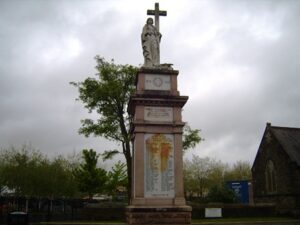
The Great War, 1914-1918
John Ash, Private, G/4521, Middlesex Regiment. John was the son of Amos and Elizabeth Ash, of Combe Florey, Somerset. He worked for the Great Western Railway, and was a Packer in the Engineering Department at Pontarddulais prior to the war. He enlisted at Swansea on 7 September 1914 into the army, and was posted to the 13th Battalion, Middlesex Regiment, which was attached to 73 Brigade, 24th Division. The Division had moved to France during August 1915 and marched to positions near Loos, where they took up reserve positions for the main Battle of Loos. They were sent into battle on 26 September 1915 at Loos and suffered terrible casualties due to not being properly trained for battle. John was killed at Loos on 28 September 1915, aged 27. He has no known grave, and is commemorated on the Loos Memorial, France.
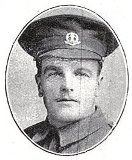
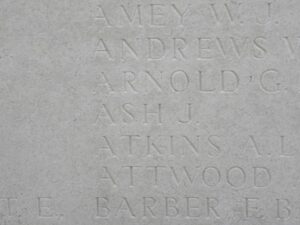
Francis George Banwell, Private, 20815, Welsh Regiment. Francis was the son of Francis and Julia Banwell, of Bungalow, Bridge Street, Pontarddulais. He had enlisted into the 15th Battalion, Welsh Regiment, which was known as the Carmarthen Pals battalion, under the name of George Banwell. Francis was wounded while training, probably at Salisbury Plain, in 1915, and returned home after having a leg amputated. No further trace of Francis’ military service can presently be traced, but he later lived at 15, High Street, Pontarddulais and died on the 11 November 1919, aged 24 years. He is not commemorated by the CWGC.
Herbert Granville Bebell, Acting Bombardier, 38014, Royal Field Artillery. Herbert was the son of Frederick John and Anne Bebell, of Cardiff. After Frederick’s death in 1902, Anne moved the family back to her native Pontarddulais. Herbert enlisted into the Royal Field Artillery, and joined the 5th Division Ammunition Column, Royal Field Artillery. The division had moved to France in August 1914, taking part in the retreat from Mons to the Marne, before fighting at La Bassée and Messines. They fought here through First Ypres, and took part in the capture of Hill 60, and then fought at Second Ypres in April 1915. Herbert died weeks after Second Ypres, on 30 May 1915, aged 30. He is buried in Bailleul Communal Cemetery Extension, France.

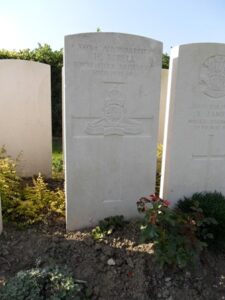
William George Bolch, Private, 49847, Lancashire Fusiliers. William was born at Cwmavon, the son of George and Mary Ann Bolch. By 1881 the family had moved to Farmers Road, Pontarddulais, where George worked as a Tinplate worker. Mary died in 1884, and George remarried. William worked as a compositor for many years, and married Jennie Fox in 1904, the couple settling down at 26, Cromwell Road, Caversham, Reading. He originally served with the Ox and Bucks Light Infantry, but transferred to the 23rd Battalion, Lancashire Fusiliers, which formed in France in May 1918 at Habarcq, near Arras as 4th Provisional Garrison Battalion and joined 176 Brigade, 59th Division. On 19 June 1918 it joined 121 Brigade, 40th Division, and took part in the advance in Flanders, and the Battle of Ypres, 1918. William was killed during the initial stage of the advance in Flanders, on 7 August 1918, aged 41. He is buried in Outtersteene Communal Cemetery Extension, France.
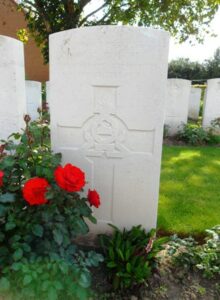
John Bowen, Private, 59427, Royal Welsh Fusiliers. John Bowen was the son of Thomas and Mary Bowen, of Maes-y-Bryn, Clynderwen. John enlisted at Pontarddulais into the 2nd Battalion, Royal Welsh Fusiliers, a Regular Army Battalion, which had served in France since landing at Rouen on 11 August 1914. The 2nd RWF was the battalion of the War Poets Robert Graves and Siegfried Sassoon, and also of the author, Frank Richards, DCM, MM. They fought during all of the major engagements on the Western Front, and on 6 February 1918 were posted to 115 Brigade, 38th (Welsh) Division. On 12 September 1918, whilst in the midst of the Battle of Havrincourt, during the advance on the Hindenburg Line, John was killed in action. He was aged just 22, and was buried in Gouzeaucourt New British Cemetery, France.
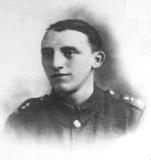
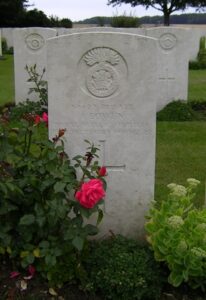
Richard James Bowen, Private, 2116, Royal Army Medical Corps. Richard was the son of Ebenezer and Margaret Bowen, of 1, Prospect Place, Llanedy. Very little information can be found about him, but he served with the Royal Army Medical Corps during the war. He died at Llanelli in 1925, aged 27. His brother, Thomas Llewellyn Bowen, won the Military Cross while fighting in East Africa during the war, for; ‘For conspicuous gallantry and devotion. A magazine was set alight by heavy shell-fire and he went alone to the position and succeeded in extinguishing the fire with wet earth, thereby saving a large quantity of ammunition.’
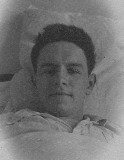
Ernest William Burridge. Private, 265775, Welsh Regiment. Ernest was the son of William Henry Burridge and Jessie Burridge (nee Morrish), of Crediton, Devon. He was living with his brother Charles at Pontarddulais prior to the war, and married Lydia Alice Maud Chandler, of 1, Wernbwll, Hendy in the summer of 1911. Ernest worked as a Tinsman for the Teilo Tinplate Company, and enlisted at Swansea into the 6th Battalion, Welsh Regiment, which was a Territorial Battalion. The battalion had been in France since October 1914, and was then attached to the 1st Division as Pioneers from October 1915. They then fought during the action at the Hohenzollern redoubt, at Loos. In 1916 the Division moved south to the Somme, where they fought during the opening of the Somme Offensive at the Battle of Albert, and then at Bazentin, Pozieres, Flers-Courcelette and Morval. They followed the German retreat to the Hindenburg Line in early 1917, and were then briefed for an operation on the Flanders Coast, and moved there during the summer of 1917. While training on the coast, the Battle of Third Ypres had stalled in the mire, and the Division were recalled to Ypres, where they fought at the Second Battle of Passchendaele. Ernest was wounded at Passchendaele, and died of his wounds on 27 October 1917. He was 29 years old, and is buried in Dozinghem Military Cemetery, Belgium.
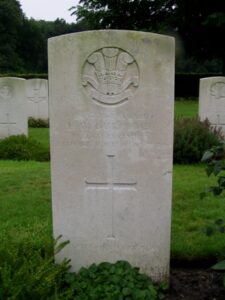
Albert Victor Carman, Able Seaman, Bristol Z/468, Royal Naval Volunteer Reserve. Albert was born on 31 December 1896, the son of William and Elizabeth Carman, of 36, Ty-ny-bone Road, Pontarddulais. He worked as a Tinworker prior to the war, and enlisted on 29 December 1914 into the Royal Naval Volunteer Reserve. He was posted to Drake Battalion, joining them at Gallipoli on 17 July 1915. Albert was invalided to Britain suffering from conjunctivitis in October 1915, and was hospitalised at the Royal Naval Hospital Haslar, suffering with Hypermetropic Astigmatism. It is not known if Albert went on to serve in France, but he died on 12 June 1920 as a result of his war service. Albert is not commemorated by the CWGC, so his place of burial is not known. He is not commemorated on the Pontarddulais War Memorial.
Frederick Thomas Cleave, Private, 33490, Devonshire Regiment. Frederick was the son of Joses and Emma Cleave, of Bedminster, Somerset. He was a coal hewer prior to working with the Great Western Railway, and was based at Pontarddulais prior to the war. He enlisted at Llanelli into the 10th Battalion, Devonshire Regiment, which was attached to 79 Brigade, 26th Division. Frederick was killed in action on the Somme on 4 September 1916, aged 35. Despite both SDGW and the CWGC recording him as serving with the 10th Devonshires, he was actually attached to the 8th Devonshires, not the 10th Devonshires, which were in Salonika at the time. He is commemorated on the Thiepval Memorial, France.
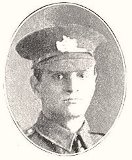
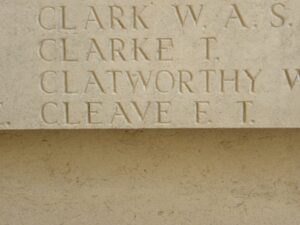
Walter David Dalby, MM, Driver, 84317, Royal Field Artillery. Walter was the son of David Walter Dalby and Sarah Hannah Dalby, of Forest Gate, London. He was a Tinplater at Pontarddulais prior to the war, and enlisted at Swansea on 22 August 1914 into the Royal Fusiliers. Walter was soon found to be underage, and was discharged from the Royal Fusiliers. He then enlisted in London into the Royal Field Artillery. Walter was posted to ‘B’ Battery, 98th Brigade, RFA. He died in hospital in London on 4 July 1918, aged 19, and is buried in Woodgrange Park Cemetery, East Ham.
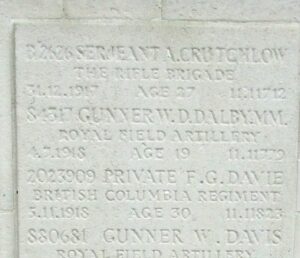
Arthur Thomas Davies, Able Seaman, Z/3581, Royal Navy. Arthur was born at Llandingat on 19 June 1897, the son of John and Gwladys Davies. By 1901 the family had moved to 3, River Terrace, Llanedy, and at some time later moved again to Brynhyfryd House, Wernbwll Road, Hendy. Arthur served in the Royal Navy, aboard the cargo steamer SS Bristol City. On 16 December 1917 the Bristol City was on voyage from Bristol to New York when she was sunk by the German submarine U-94, with the loss of 30 lives. Arthur was just 20 years old when he died that day, and is commemorated on Panel 24 of the Plymouth Naval Memorial, Devon.
Daniel Davies, Private, 15915, Welsh Regiment. Daniel was born at Oakfield Street, Pontarddulais, and enlisted at Neath into the 10th Battalion, Welsh Regiment. The battalion was raised as the First Rhondda Battalion, and moved to France in December 1915 attached to 114 Brigade, 38th (Welsh) Division. The Division moved to the Fleurbaix sector where it was initiated into trench warfare over the coming months. Daniel was killed while the battalion was in the line at La Quinq Rues on 2 April 1916. He is buried in Le Touret Military Cemetery, Richebourg-L’avoue, France.

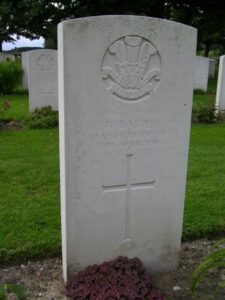
George Davies, Sapper, 448501, Royal Engineers. George was the son of Thomas Davies, of Carreglas, Cross Hands, and the Husband of Mrs. Davies, of Glynllwchwr Road, Pontarddulais. George had served at Gallipoli with the Welsh Field Company, Royal Engineers, and had been wounded on three occasions before joining the 90th Field Company, Royal Engineers, which was attached to the 9th (Scottish) Division. The Division had taken part in the Battle of the Somme in 1916, and had fought at Arras and Ypres the following year, before taking part in the Battle of Cambrai. In March, 1918 they were still in the Cambrai area, and were one of the Divisions hit there by the German Spring Offensive, fighting at the Battle of St Quentin, and the First Battle of Bapaume. After suffering terrible casualties the Division were moved to Flanders to rebuild, but the Germans launched another offensive there during April, 1918, and the Division then took part in the Battles of the Lys, at the Battle of Messines, the Battle of Bailleul, the First Battle of Kemmel, the Second Battle of Kemmel and then took part in the Action of Outtersteene Ridge, and the Advance in Flanders. George was mortally wounded during the advance, and died at St. Omer on 1 August 1918. He is buried in Longuenesse (St. Omer) Souvenir Cemetery, France.

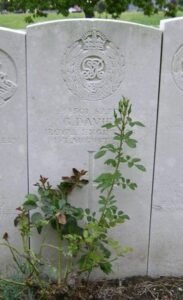
Nathaniel Davies, Private, 20927, Welsh Regiment. Nathaniel was the son of Edward and Catherine Davies, of 2, Market Street, Lampeter. He was a Driver prior to the war, and lived at 4, Factory Road, Pontarddulais. Nathaniel enlisted at Ammanford on 10 April 1915 into the 15th Battalion, Welsh Regiment. The battalion would become known as the Carmarthen Pals, and was attached to 114 Brigade, 38th (Welsh) Division. The Division crossed to France in December 1915 and took the line near Fleurbaix, where it trained in trench warfare. On 9 March 1916 the 15th Welsh were in the line at Grenadier Street, Cuinchy, when the Germans exploded two huge mines underneath part of their line, and then bombarded the Welsh trenches. Nathaniel was killed during the mine explosion. He was 19 years old, and is buried in Guards Cemetery, Windy Corner, Cuinchy, France.
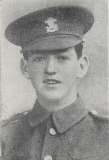
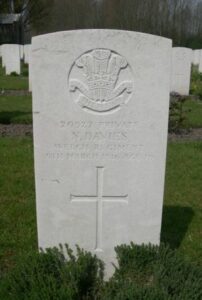
Samuel Mathias Davies, Private, 37569, Welsh Regiment. Samuel was born in Cilrhedyn, the son of Benjamin and Jane Davies. The family had moved to Llangennech prior to the war, and Samuel enlisted at Pontarddulais into the 8th Battalion, Welsh Regiment, which was attached to 40 Brigade, 13th (Western) Division. On 13 June 1915 the Division sailed to Alexandria. Between 6 and 16 July 1915 the Division landed on Cape Helles and relieved the 29th Division. They left and returned to Mudros at the end of the month, and the entire Division landed at ANZAC Cove between 3 and 5 August 1915, taking part in the Battles of Sari Bair, Russell’s Top, and Hill 60, ANZAC. Soon afterwards the Division was transferred from ANZAC to Suvla Bay, and it was evacuated from Suvla on 19 December 1915, when it moved to the Helles bridgehead, where they faced the last Turkish attacks at Helles. On 8 January 1916, the Division was evacuated from Helles, and by 31 January was concentrated at Port Said, where they held forward posts in the Suez Canal defences. On 12 February, 1916 the Division began to move to Mesopotamia, to strengthen the force being assembled for the relief of the besieged garrison at Kut al Amara. By 27 March, the Division had assembled near Sheikh Saad and came under orders of the Tigris Corps, and then took part in the attempts to relieve Kut. Samuel sadly died of sickness in Mesopotamia on 21 April 1916, aged 20, and is buried in Amara War Cemetery.

Thomas Ellison, Private, 13176, Devonshire Regiment. Thomas was born at Wigan in 1887, the son of Hugh and Elizabeth Ellison. He worked at Pontarddulais prior to 1911, and had married Sarah Bevan in 1907. The couple lived at Golden Grove Goppa, Pontarddulais, where their seven children were born. Thomas enlisted at Swansea into the 9th Battalion, Devonshire Regiment, and on 28 July 1915 the battalion landed at Havre, joining 20 Brigade, 7th Division at Calonne sur-la-Lys. Thomas then fought at the Battle of Loos in September 1915, and in 1916 fought on the Somme. In March 1917 they followed up the German Retreat to the Hindenburg Line, and took part in Flanking Operations Round Bullecourt. The 7th were moved into a scene of incredible ferocity at Bullecourt, a strongly fortified village on the Hindenburg Line, and alongside the Australians played a major role in penetrating the village defences. Later in the year the Division moved to Ypres, and fought at the Battle of the Polygon Wood. They then took part in the Battle of Broodseinde, the Battle of Poelcapelle and the Second Battle of Passchendaele. Thomas was wounded at Passchendaele, and died on 4 October 1917, aged 30. He is buried in Menin Road South Military Cemetery, Belgium. Sarah married Stanley Williams in 1918.
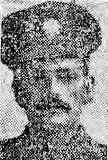
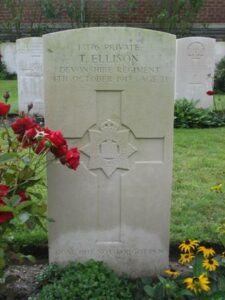
David Evans, Master, Mercantile Marine. David was the husband of M. A. Evans, of 3, Harries Avenue, Old Road, Llanelly. He served with the Mercantile Marine, as Master of the SS Thornaby. David lost his life when Thornaby struck a mine which had been laid by a German submarine and sank in the North Sea on 1 March 1916. He was 61 years old, and is commemorated on the Tower Hill Memorial, London.
David John Evans, Private, 220, Welsh Guards. David was the son of David and Anne Evans, of 1, Sawel Terrace, Llanedi, and later of 7, Harleyford Road, Hendy. He served with the Glamorgan Constabulary prior to the war, before enlisting at Llanelli into the Grenadier Guards. David then transferred to the newly formed Welsh Guards early in 1915. The Welsh Guards were then attached to 3 Guards Brigade, Guards Division, which was formed in France in August 1915, and saw its first major action during the Battle of Loos on 25 September 1915. During the coming months they also fought in the subsequent Action of Hohenzollern Redoubt. In July, 1916 the Division moved to the Somme, where they fought at the Battle of Flers-Courcelette, and then at the Battle of Morval, capturing Lesboeufs Village. They remained here for the winter, and in March, 1917 took part in the advance caused by the German Retreat to the Hindenburg Line. Later that year they moved north to Ypres, where they fought at the Battle of the Pilkem. David was killed here on 31 July 1917. He was 24 years old, and is buried in Duhallow A.D.S. Cemetery, Belgium. His brother, Trevor Lewis Evans, also fell.
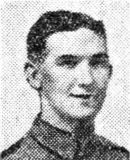
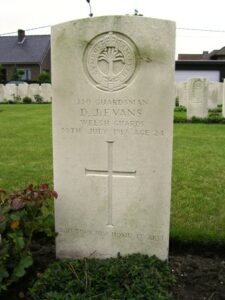
David John Evans, Gunner, W/829, Royal Field Artillery. David was the son of James and Rachel Evans, of Green Plain Cottage, Letterston. He enlisted at Bridgend into the 54th Battery, 39th Brigade, Royal Field Artillery. This was a regular Army Battery, attached to the 1st Division, and they had been in France since the retreat from Mons in August 1914. He was Killed in Action during the Battle of the Somme, on 13 August 1916, aged 22. David was buried in Quarry Cemetery, Montauban, France. His brother Samuel also fell.
Llewellyn Evans, Pioneer, 62948, Royal Engineers. Llewellyn was the son of William Henry and Helen Evans, of Glan-yrafon, Pentreffynon, Skewen, and lived at Pontarddulais prior to the war. He enlisted at Neath into the 38th Division Signal Company, Royal Engineers, which moved to France with the Division in December 1915. Llewellyn probably joined the Division at Ypres in 1917, and saw service there at the Battle of Pilckem Ridge. After the successful capture of Pilckem, the 38th Division was moved to positions near Armentieres. Llewellyn was wounded at Armentieres in March 1918, and died of his wounds on 26 March 1918. He was 20 years old, and is buried in Merville Communal Cemetery Extension, France.
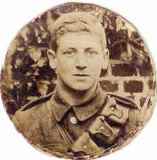
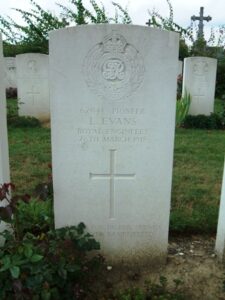
Sidney William Evans, Private, 18699, Welsh Regiment. Sidney was born at Llandilo Talybont, the son of Thomas and Eva Evans, of Pleasant View. The family later resided at 20 Garn Goch Terrace, Garden Village, Gorseinon, Swansea. Sidney enlisted at Gorseinon into the 9th Battalion, Welsh Regiment, which was attached to 58 Brigade, 19th (Western) Division. Sidney landed in France with the 9th Welsh on 18 July 1915, and the Division moved to positions north of Loos, near Neuve-Chapelle. The Division took part in its first major action during the opening day of the Battle of Loos, on 25 September 1915. The men of the 9th Welsh climbed from the trenches to assault the German lines opposite, only to be mown down by Machine-Gun fire, before they had moved 100 yards from their trenches. Sidney was one of over 200 casualties suffered by the 9th Welsh that day. He was just 18 years old, and is commemorated on the Loos Memorial, France.
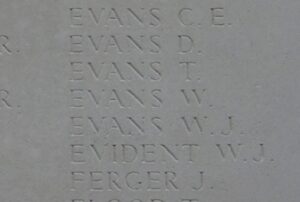
Trevor Lewis Evans, Trooper, 3412, Household Cavalry. Trevor was probably the son of David and Ann Evans, of 1, Sawel Terrace, Llanedi. He enlisted at Llanelli into the 1st Life Guards, Household Cavalry. On 7 October 1914 they landed at Zeebrugge attached to the 3rd Cavalry Division. Other than in the first two weeks when it was used in the traditional cavalry, for mobile reconnaissance, it fought most of the war as a dismounted force, and saw action at First Ypres, Second Ypres, Loos and Arras. For most of the time, it took its turn in holding various sections of the front, while remaining prepared to exploit breakthroughs in battle, but opportunities rarely presented themselves. Trevor was killed near the Hindenburg Line on 7 February 1918, aged 22. He was buried in Tincourt New British Cemetery, France.
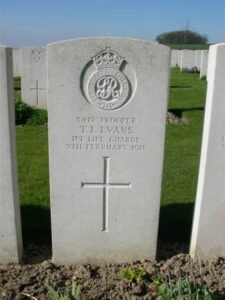
Walter James Evans, Private, 12721, Devonshire Regiment. Walter was the son of James and Sarah Evans, of 5, Brynlliw Cottages, Grovesend, near Pontarddulais. He served with the 9th Battalion, Devonshire Regiment, which landed in France on 28 July 1915, and became attached to 20 Brigade, 7th Division. The battalion saw its first action during the Battle of Loos in September, and then moved to positions on the Somme, near Fricourt, early in 1916. Walter was wounded near Fricourt soon after, and died of his wounds on 16 February 1916. He was 21 years old, and is buried in Corbie Communal Cemetery, France.
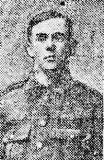
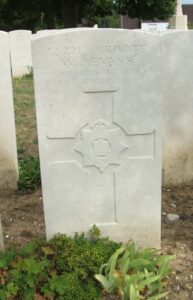
William Auryn Evans, Private, 39508, Welsh Regiment. William was born in Aberdare, the son of John and Hannah Evans. The family resided at Glazier Row, Newcastle Emlyn prior to the war, before William moved to Tyn y Bonau, Pontarddulais. He enlisted at Llanelli into the 2nd Battalion, Welsh Regiment, which was attached to 3 Brigade, 1st Division. William joined the Battalion in 1916, after it had taken part in the Battles of Aubers and Loos. Again they were required for a major offensive, moving south to the Somme, where they fought during the opening of the Somme Offensive at the Battle of Albert, then at Bazentin, Pozieres, Flers-Courcelette and Morval. They followed the German retreat to the Hindenburg Line in early 1917, and were then briefed for an operation on the Flanders Coast, and moved there during the summer of 1917. While training on the coast, the Battle of Third Ypres had stalled in the mire, and the Division were recalled to Ypres, where they fought at the Second Battle of Passchendaele where William was killed in action on 9 November 1917, aged 19. He has no known grave, and so is commemorated on the Tyne Cot Memorial, Belgium.
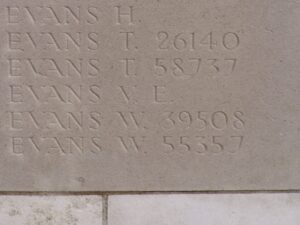
William Davies Evans, Sergeant, 4190, South African Infantry. William was born in Montgomery in 1878, the son of George Evans, later of Tenby Cottage, Usk, and had resided at Pontarddulais at some time, probably marrying Alice Ellen of Pontarddulais in 1895. He was a regular soldier, having served for eight years with the 11th Hussars, and for over five years with the 6th Dragoon Guards, seeing service in India and during the Boer War, before emigrating with his family to South Africa, where he bought a farm. He re-enlisted in South Africa in September 1915, joining the 1st South African Infantry. William served in France with the South Africans, and was badly wounded at Delville Wood in August 1916. He was sent to the Base Hospital at Rouen for treatment, and after five months recovering rejoined his unit, only to be wounded again, returning to Rouen in November 1917, where he spent another seven months. William then had problems with severe abscesses, probably due to his wounds, and was invalided to South Africa, where he could only walk with crutches, and developed a bad cough. He was awarded a generous pension in 1921, but must have died soon after, as his list of conditions was pretty long, and he was still hospitalised at Port Elizabeth in February 1921. Nothing else is known of him.
William James Evans, Private, 30738, Welsh Regiment. William was born at Pontarddulais, and enlisted at Llanelli into the army. He was posted to the 1st Battalion, Welsh Regiment, which was attached to 3 Brigade, 1st Division, and had been in France since the Battle of Mons in August 1914. William landed in France on 22 June 1915, and joined the battalion south of Ypres. William was killed on 3 August 1915. He has no known grave, and is commemorated on the Ypres (Menin Gate) Memorial, Belgium. William is not commemorated on the Pontarddulais War Memorial, but is possibly named on there as David John Evans.
William John Evans, Private, PO/748/S, Royal Marine Light Infantry. William was born on 26 October 1895, the son of William and Jane Evans, of Maes-y-Brawdd, Pontarddulais. He enlisted into the Royal Marine Light Infantry, and served with the 1st Royal Marine Battalion prior to the war. William then transferred to the Portsmouth Division, and fought at Gallipoli, being wounded in May 1915 and evacuated back to Britain. He went AWOL in January 1918, but was caught and sentenced to 60 days detention. He was then court-martialled for another offence, and sentenced to a year’s detention, but instead opted to embark for France on 6 August 1918, probably joining Anson Battalion, Royal Naval Division. William was killed in action six weeks later, on 27 September 1918, aged 22. He was buried in Sucrerie British Cemetery, Graincourt-les-Havrincourt, France.
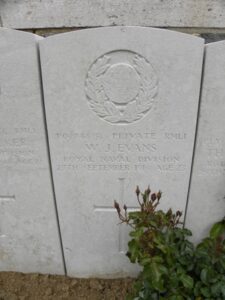
Frederick George Garland, Corporal, 3972, Royal West Kent Regiment. Frederick was born at Enfield, Middlesex. He resided with his uncle Jesse Phillips at 12, Williams Street, Pontarddulais for several years prior to the war and married Elsie Rosina Chandler at Pontarddulais in 1912. Frederick was probably an army reservist, and served with the 8th Battalion, Royal West Kent Regiment, which was attached to 72 Brigade, 24th Division. The Division moved to France during August 1915 and marched to positions near Loos, where they took up reserve positions for the main Battle of Loos. They were sent into battle on 26 September 1915 at Loos and suffered terrible casualties due to not being properly trained for battle, and were pulled from the line until the following year. In 1916 they took part in the Battle of the Somme, and fought at Delville Wood and Guillemont, before moving north of Arras in early 1917. In April and May 1917 they fought at the Battle of Vimy, alongside the Canadian Corps. Frederick was wounded at Vimy, and died of wounds on 9 April 1917, aged 26, and is buried in Bethune Town Cemetery, France. Frederick is not commemorated locally, but his widow later remarried, becoming David Jones, and resided at 2, Toll Gate House, Hendy, Pontarddulais.
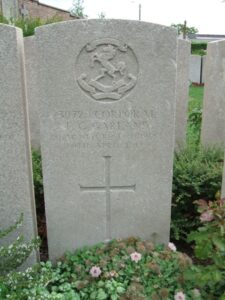
Albert Richard Griffiths, Private, 430453, Canadian Pioneers. Albert was born on 20 January 1890, the son of Edward and Ruth Griffiths, of Pistyllgwyn, Pontarddulais. Albert emigrated to Canada in 1911, and lived in British Columbia, where he worked as a Miner. Albert enlisted at Victoria, British Columbia on 11 March 1915 into the Canadian Expeditionary Force, and was posted to the 3rd Pioneer Battalion. The battalion moved to France in January 1916 attached to the 3rd Canadian Division, and moved to positions south of Ypres. On 2 June 1916 the Canadians were attacked by a strong German force, in an action which was to become known as the Battle of Mount Sorrel. During heavy fighting, the 3rd Canadian Pioneers were sent to dig new trenches, and to strengthen existing defences. Albert was killed while carrying out this vital work on 3 July 1916. He was 26 years old, and is commemorated on the Ypres (Menin Gate) Memorial, Belgium.

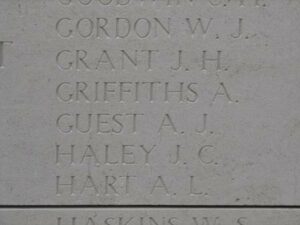
David Daniel Griffiths, Private, 19886, Welsh Regiment. David was the son of David and Elizabeth Griffiths, of Glanyrafon Road, Pontarddulais. He enlisted there into the 15th Battalion, Welsh Regiment, which was known as the Carmarthen Pals battalion. David later transferred into the 18th Battalion, Welsh Regiment, the 2nd Glamorgan Bantams. The battalion was attached to 119 Brigade, 40th (Bantam) Division, and moved to France during June 1916, and moved to the front near Loos. Late in 1916 they moved south to the Somme, and fought at the Battle of the Ancre, and remained in the area over the winter. In March, 1917 the Germans withdrew to their shortened line, called the Hindenburg Line, and the 40th Division were one of the Divisions that followed the withdrawal. Later in the year they took part in the Battle of Cambrai, playing an important role in the attack on Bourlon Wood. David was taken ill at Cambrai, and evacuated to the Base Hospital at Étretat. He died there on 5 December 1917, aged 31, and is buried in Étretat Churchyard Extension, France.
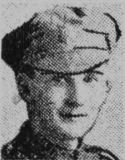
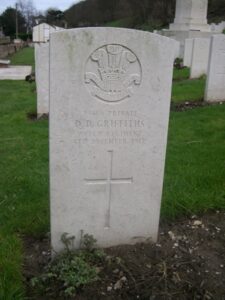
Ivor Griffiths, Private, 241790, Welsh Regiment. Ivor was the son of Griffith and Hannah Griffiths, of Henfaes, Glanyrafon Road, Pontarddulais. He enlisted at Pontarddulais into the 1/5th Battalion, Welsh Regiment, which was the Pontypridd area Territorial Battalion, attached to the 53rd (Welsh) Division. The Division moved to the Mediterranean in July 1915, and landed on Gallipoli on 9 August. Here the Division was immediately thrown into action, and spent the next few days in isolated pockets, fighting against a Turkish counter-attack during the Battle of Sari Bair, and then at the Attack on Scimitar Hill. The Division remained here throughout the coming months, and suffered severe losses in manpower strength during the great November 1915 blizzard on Gallipoli, when its total strength was reduced to less than that of a full-strength Brigade. On 11 December 1915 the Division was evacuated to Mudros, and by 23 December 1915 were moved to Egypt. They remained on the Suez Canal Defences for the next twelve months, and in early 1917 moved into Palestine, where the Welsh took part in the First Battle of Gaza. Ivor was killed here on 26 March 1917, aged 25, and is commemorated on the Jerusalem Memorial, Israel.
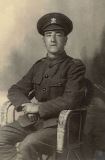
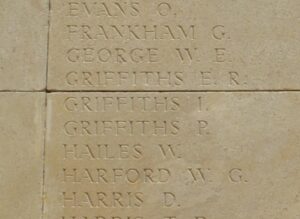
Joseph Harrop Griffiths, Second Engineer, Mercantile Marine. Joseph was the son of David Griffiths and Charlotte Griffiths (nee Harrop), of Brondeg, Pontarddulais. He was a steam engine builder at Bolton prior to the war and enlisted into the Mercantile Marine. Joseph was posted aboard the SS Daybreak, a West Hartlepool registered ship. On 24 December 1917 Daybreak was on voyage carrying a cargo of maize when she was sunk by a torpedo which had been fired without warning by a German submarine, near South Rock Lightship, Strangford Lough, Co Down. The entire crew were lost. Joseph was 23 years old, and is commemorated alongside his shipmates on the Tower Hill Memorial, London.
Matthew Henry Griffiths, Private, 12550, Welsh Regiment. Matthew was the son of William John and Elizabeth Anne Griffiths, of Pontarddulais. He enlisted at Swansea into the 19th Battalion, Welsh Regiment, which was attached to the 38th (Welsh Division as the Pioneer battalion. The Division moved to France in December 1915, and after being initiated into trench warfare at Fleurbaix, fought at Mametz Wood in July 1916. It was then sent to positions north of Ypres, at Boesinghe, where it remained for the next twelve months, in preparation for their part in the attack on the Pilckem Ridge on 31 July 1917. Matthew was wounded during the build up to the offensive, and died of his wounds on 24 July 1917. He was 22 years old, and is buried in Dozinghem Military Cemetery, Belgium.
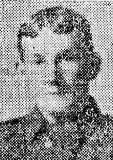
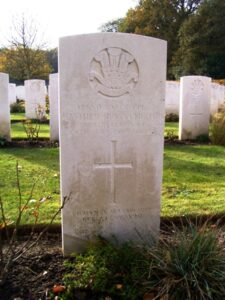
William John Griffiths, Private, 11200, Welsh Regiment. William was the son of Tom and Ann Griffiths, of 6, Highland Terrace, Pontarddulais. He served with the 2nd Battalion, Welsh Regiment, which landed in France in August 1914 attached to 3 Brigade, 1st Division. The Division had been one of the first to arrive in France, fighting at the Battle of Mons, and taking part in the retreat to the Marne, where the Germans were stopped. They then fought at the Aisne, and at Chivy, before being moved north to Ypres. Here they fought at the First Battle of Ypres, where they again stopped the German Offensive, before wintering in Flanders. The following year saw them in action again at the Battle of Aubers, before moving South to Loos, where they fought during the Battle of Loos, and the action at the Hohenzollern redoubt. William was wounded at Loos, and died on 1 October 1915, aged 22. He is buried in Lapugnoy Military Cemetery, France.
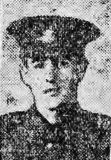
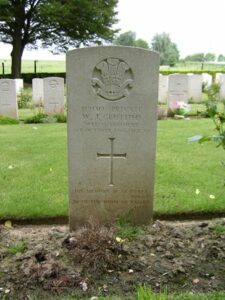
John Arthur Harley, Driver, 91945, Royal Field Artillery. John was born in Pontarddulais in 1891, the son of John and Elizabeth Harley. By the outbreak of war the family was residing at 15, Queen Street, Blaengarw. John worked for the GWR and enlisted at Pontycymmer into the Royal Field Artillery, before being posted to France to join their 51st Anti-Aircraft Battery. John died in Calais on 26 December 1916. He was 25 years old, and is buried in Calais Southern Cemetery, France. John is not commemorated on the Pontarddulais memorial.
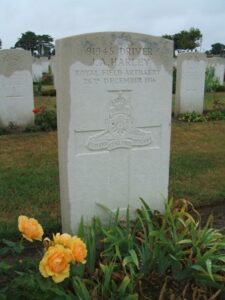
David George Harries, Private, 203, Canadian Infantry. David was born on 10 August 1880, the son of Rees and Ann Harries, of Bolgoed, Pontarddulais. Educated at Llandovery from 1895 to 1901, David played cricket for the School 1st Xl, and rugby for the 2nd XV, at centre. After leaving School David emigrated to Canada where he became a farmer, and served in the Queen’s Royal Scots. On 14 December 1914 he enlisted in the Saskatchewan Light Horse at Winnipeg, but died of disease in Canada on 17 January 1915 aged 34. David is buried in the Winnipeg (Brookside Cemetery) Manitoba, Canada.
William Harts, Private, 12621, Welsh Regiment. William was born at Hirwain in 1888. He married Lydia J. Rhodes in 1905, and the couple came to live at 24, Williams Street, Pontarddulais prior to the war. William enlisted at Swansea into the 2nd Battalion, Welsh Regiment, which moved to France in August 1914 attached to 3 Brigade, 1st Division. The Division had been one of the first to arrive in France, fighting at the Battle of Mons, and taking part in the retreat to the Marne, where the Germans were stopped. They then fought at the Aisne, and at Chivy, before being moved north to Ypres. Here they fought at the First Battle of Ypres, where they again stopped the German Offensive, before wintering in Flanders. William was killed in action at Ypres on 21 December 1914, aged 32 and is commemorated on the Le Touret Memorial, Richebourg L’Avoue, France.

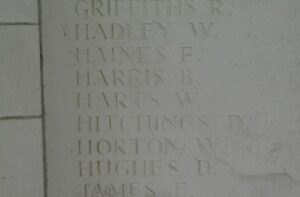
Richard Stephen Holloway, Private, 44693, Welsh Regiment. Richard was the son of Stephen and Mary Ann Holloway, of Bryn, Llangennech. He worked as a shoemaker prior to enlisting into the Welsh Regiment and was posted to the 23rd Battalion, Welsh Regiment, which was known as the Welsh Pioneers and was attached to the 28th Division. He served in Salonika with the 23rd Welsh before contracting Malaria and was sent back to England for treatment before being discharged as physically unfit. He died of malaria on 18 March 1920, aged 23. His case was recently forwarded to the CWGC as a result of my research, and he was accepted for commemoration by them on Tuesday 25 August 2020. He will be commemorated in the United Kingdom Book of Remembrance at Maidenhead unless the location of his grave can be traced.
Daniel Idwal Hopkins, Second Lieutenant, South Wales Borderers. Daniel was the son of David and Mary Hopkins, of 13, Oakfield Street, Pontarddulais. He was commissioned into the South Wales Borderers, and was posted to France to join the 2nd Battalion, which was attached to 87 Brigade, 29th Division. The 2nd SWB had fought in China at the outbreak of war, then at Gallipoli. It then moved to France in 1916, and took part in its first major action in France during the 1916 Somme Offensive, fighting at the Battles of Albert and Le Transloy, suffering heavy casualties. In the spring of 1917 they fought at the Battle of the Scarpe, which was part of the Arras Offensive, and it was there that Daniel was killed on 23 April 1917, aged 27. He is commemorated on the Arras Memorial, France.
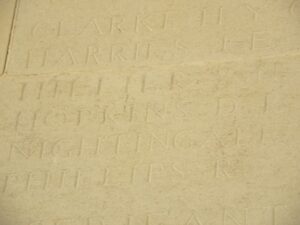
Albert House, Private, 17938, Oxfordshire and Buckinghamshire Light Infantry. Albert was the son of George and Eliza House, of Thatcham, Berkshire. He worked as a railway platelayer prior to the war, and in 1907 married Martha Anne Bowen, of Railway Terrace, Ferryside. The couple resided there for at least four years, where their children Harold and Emily were born, before moving to Pontarddulais. Albert enlisted at Swansea into the army, and was posted to the 7th Battalion, Oxfordshire and Buckinghamshire Light Infantry, who were attached to 78 Brigade, 26th Division. The Division moved to France in September 1915 and assembled around Amiens, but were sent to Salonika in November that year, and were all in place there by February 1916. The Division fought in the Battle of Horseshoe Hill in August 1916, and in April and May 1917 fought in the Battle of Doiran, where Albert was killed in action on 26 April 1917, aged 34. He is buried in Sarigol Military Cemetery, Kriston. Albert is not named on the Ferryside Memorial. His widow Martha married Llewellyn Francis, of Pontarddulais in 1920, before returning to Ferryside to live. She died in 1972.
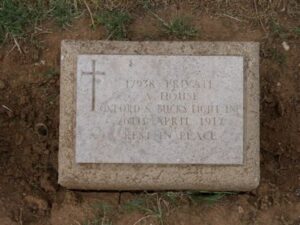
John Thomas Howells, DCM, Sapper, 79886, Royal Engineers. John was the son of Thomas John and Margaret Howells, of Craig Cefn Parc, Swansea. He had originally served in the Devonshire Regiment, before being posted to the 177th Tunnelling Company, Royal Engineers. The Company formed in June 1915, and moved to Wytschaete. In November 1915 it and moved to Railway Wood, where it remained for two years. March 1918 saw the Company working on construction of the Fifth Army’s Green Line near Templeux, when the German attack struck. After this the Company was engaged in Somme bridge demolition, and other defensive activities. John was killed in action during the final offensive on 4 October 1918. He was 36 years old, and is buried in Anneux British Cemetery, France. He had been awarded the Distinguished Conduct Medal for gallantry at Mount Sorrel, the citation in the London Gazette, published on 25 July 1916, reading; ‘For conspicuous gallantry. With a squad of five men, after twenty-two hours’ work under very dangerous conditions, he rescued two men who had been buried in a gallery through the explosion of enemy mine.’

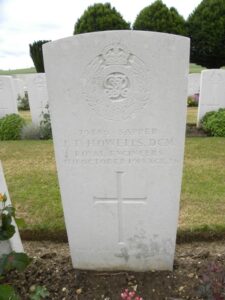
Thomas Hughes, Private, 12874, Devonshire Regiment. Thomas was the son of Thomas and Frances Hughes, of Myrtle House, Mynyddllno, Pontarddulais. He worked as a coal haulier prior to the war and enlisted at Swansea into the 2nd Battalion, Devonshire Regiment. The battalion had landed in France on 6 November 1914, attached to 23 Brigade, 8th Division. They saw their first major action at the Battle of Neuve Chapelle, and it was there that Tom was killed on 13 March 1915. He was 22 years old, and is commemorated on the Le Touret Memorial, France.
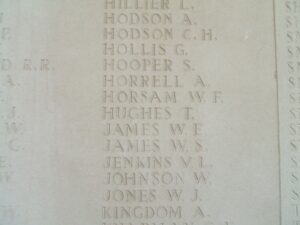
William Hughes, Private, 20750, Welsh Regiment. William was probably the son of Thomas and Hannah Hughes, of Sardis Cottage, Llanedy, Pontarddulais. He enlisted at Ammanford at the outbreak of war into the 15th Battalion, Welsh Regiment, known as the Carmarthen Pals. The battalion trained at Rhyl until the summer of 1915 when it moved to Winchester as part of 114 Brigade, 38th (Welsh) Division. In December 1915 the Division moved to France, where it took the line near Fleurbaix, where it was initiated into trench warfare. In June 1916, the Division moved to the Somme, where it captured Mametz Wood, before being posted to positions north of Ypres, where it remained until taking part in the Battle of Pilckem Ridge, and the Battle of Langemarck. William was killed here on 7 September 1917, aged 36. He has no known grave, and is commemorated on Panel 93-94 of the Tyne Cot Memorial, Belgium.
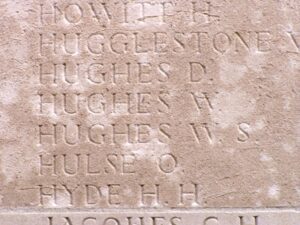
Albert Ince, Private, 18230, South Wales Borderers. This is the only man of this name who has a remote connection to South Wales. Albert was the son of John and Elizabeth Ince, of 90, Maroon Street, Stepney, London. He was a pre-war regular, and had served with the 2nd Battalion, South Wales Borderers prior to the war. Sometime afterwards, he was posted to the 1st Battalion, which was attached to 3 Brigade, 1st Division. The Division landed in France on 13 August 1914, and fought in the Battle of Mons, and the subsequent retreat to the Marne. It then played an important role in the First Battle of Ypres, where the 1st SWB helped stop the German attack at Gheluvelt. Involved in several major actions throughout 1915, the Division was at Loos over the winter of 1915/16. Albert was killed in the attempt to capture Hart’s Crater, at Loos, on 22 February 1916. He was 28 years old, and is buried in St. Mary’s A.D.S. Cemetery, Haisnes, France.
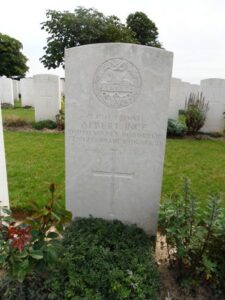
Brinley Jenkins, Private, 69634, Royal Welsh Fusiliers. Brinley was born at Llangennech, the son of Philip and Margaret Ann Jenkins. By 1911 the family was residing at The Bungalow, Graigfawr, Pontarddulais. Brinley enlisted at Swansea into the 8th Battalion, Royal Welsh Fusiliers, which was attached to 40 Brigade, 13th (Western) Division. During July 1915 the entire Division landed on Gallipoli, and took part in several bloody battles there. During January 1916 the men were evacuated to Egypt, and from there marched into Mesopotamia. It remained here for the remainder of the war, helping to free this ancient country from centuries of Turkish rule. Brinley was one of many men to become ill in this inhospitable country, and died on 15 October 1918 aged 21. He has no known grave, and is commemorated on Face 4 of the Kirkee 1914-1918 Memorial, India.
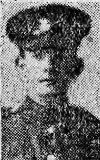
John Jenkins, Stoker, 341736, Royal Navy. John was born at Haverfordwest on 27 March 1877, the son of David and Sarah Jenkins. He had worked as a boilerman at Pontarddulais prior to the war, and lived with his wife, Mary Jenkins, at Glanyrafon Road, Pontarddulais. John served with the Royal Navy aboard H.M.S. Ariadne. HMS Ariadne was a ship of the Diadem-class of protected cruiser in the Royal Navy. She had been built by J&G Thompson of Clydebank and launched on 22 April 1898. In March 1913 she was converted to a stokers’ training ship and in 1917 was converted to a minelayer and assigned to the Nore Command. She was torpedoed and sunk off Beachy Head by UC-65 on 26 July 1917. John was one of the men killed when the Ariadne went down. He was 39 years old. His body was washed ashore, and so John was brought home to be buried in Rhydgoch Cemetery, Pembrokeshire.
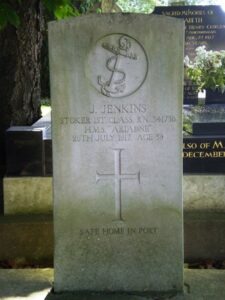
David John Jeremiah, Private, 12967, Devonshire Regiment. David was the son of John and Mary Jeremiah, of Morriston. After his father’s death, Mary remarried, and the family moved to Glanllwchur Cottages, Calcerrig Road, Pontarddulais. David had enlisted at Swansea into the 1st Battalion, Devonshire Regiment, which was attached to 14 Brigade, 5th Division. The Division had fought in most of the major battles since arriving in France in August 1914. By mid 1917 it was at Ypres, and David was attached to the 184th Tunnelling Company, Royal Engineers at Ypres. He was wounded by shellfire during the Battle of Langemarck, and died of his wounds at Proven on 6 August 1917, aged 24. David is buried in Mendinghem Military Cemetery, Belgium.

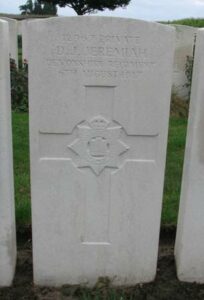
Albert Henry Jones, Private, 162750, Machine Gun Corps. Albert was the son of John and Mary Jones, of 1, Lliw Terrace, Pontlliw, Pontarddulais. He married in 1909, and lived with his wife Selina Jones at Swansea. Albert originally served with the King’s Shropshire Light Infantry, before transferring to the 18th Battalion, Machine Gun Corps, which was attached to the 18th (Eastern) Division. The Division had been in France since May 1915, and had seen its first major action during the Somme offensive in 1916, and in 1917 fought at Arras and at Third Ypres. In 1918 the Division was stationed south of the Somme, and was hit by the German Spring Offensive of 21 March 1918, seeing heavy fighting. On 8 August 1918 they formed part of the force which attacked the German positions around Villers Brettoneux, south of the Somme Valley, during the Battle of Amiens, and then took part in the Battle of Albert, which began the great push by the Allies which ended the war. The Division then took part in the drive towards the Hindenburg Line. Albert was killed near the end of the war, during the Battle of the Sambre, on 5 November 1918. He was 35 years old, and is buried in Premont British Cemetery, France. Albert is not commemorated at Pontarddulais.
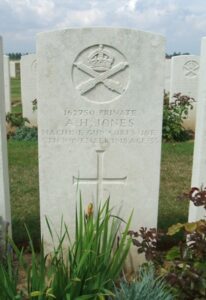
Andrew Jones, Private, 16005, Northumberland Fusiliers. Andrew was the son of John and Mary Jones, of 17, Llwynmeurig Terrace, Pontarddulais. He enlisted into the army, and was posted to France to join the 11th Battalion, Northumberland Fusiliers, which was attached to 68 Brigade, 23rd Division, and landed in France in August 1915. Andrew was then posted to the 176th Company, Royal Engineers. He died in France on 5 July 1916 aged 27, and is buried in Barlin Communal Cemetery Extension, France. Andrew is not commemorated on the Pontarddulais Memorial.
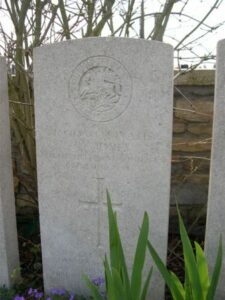
David John Jones, Private, 29045, South Wales Borderers. David was the son of Evan and Rachel Jones, of Allt y Coed House, Bolgoed Street, Pontarddulais. He enlisted at Ammanford into the South Wales Borderers, and served with the 3rd Battalion on Home Service. David took ill and died of pneumonia on 28 January 1917, aged 33. He is buried in Pontarddulais (St. Teilo) Churchyard, Wales.
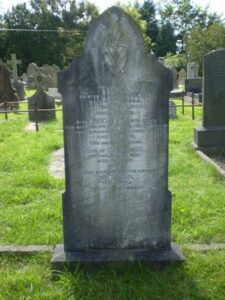
David Noel Jones, Private, 2009, Welsh Regiment. David was born at Cwmhir, Radnorshire, the son of John George and Matilda Jones. He resided at Pontarddulais prior to the war, and enlisted at Swansea into the 1/6th Battalion, Welsh Regiment. The battalion landed in France on 29 October 1914, and moved to work on Lines of Communication around Calais. On 5 July 1915 it became attached to 84 Brigade, 28th Division, and on 23 October 1915 transferred to 3 Brigade, 1st Division. The Division was at Loos, and it was here on 22 November 1915 that David was killed. He was 25 years old and is buried in Dud Corner Cemetery, Loos, France. David is not commemorated on the Pontarddulais War Memorial.
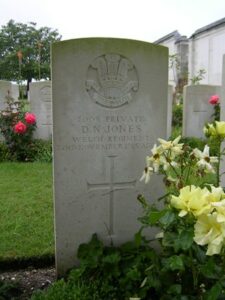
Ernest Jones, Stoker, 3794S, Royal Navy. Ernest was born at Pontarddulais on 25 June 1896, the son of William and Mary Ann Jones. The family later resided at Maes-Yr-Haf, Bradford Street, Llanelli. Ernest served with the Royal Navy aboard HMS Defence. Defence was a Minotaur Class armoured cruiser, and had been built at Pembroke Dockyards. She saw extensive service around the world, and became the flagship of Rear Admiral Sir Robert Arbuthnot, leading the First Cruiser Squadron at the Battle of Jutland on 31 May 1916. Defence was blown apart by German gunfire at Jutland on 31 May 1916, and sank with the loss of all hands. Ernest was 19 years old, and is commemorated on the Plymouth Naval Memorial, Devon. Ernest is not commemorated on the Pontarddulais War Memorial, but is commemorated on his parents’ grave at Llanelli.
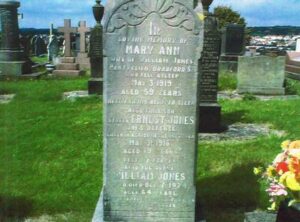
Griffith Elphin Jones, Cadet, Mercantile Marine. Griffith was born in 1901, the son of Griffith and Catherine Jones, of Capel Newydd, Hendy, Pontarddulais. He joined the Mercantile Marine as a Cadet, and served aboard the Elder-Dempster Line Steamship RMS Burutu. On 3 October 1918, Burutu was sailing through St. George’s Channel, on voyage from Lagos, W. Africa to Liverpool with a general cargo, and tin ingots. In poor conditions, she was struck midships by the Glasgow registered S.S. City of Calcutta, and sunk in minutes with the loss of 150 lives. Griffith was just 17 years old when he died that day, but because the ship was not a war loss, he is not commemorated by the Commonwealth War Graves Commission. Many thanks to Martin Thomas for helping to identify Griffith.
Idris Jones, Private, 12752, Devonshire Regiment. Idris was born at Pontarddulais, probably the son of Morgan and Sarah Jones, of Ashgrove House, Tynybone, Pontarddulais. He enlisted at Swansea into the 2nd Battalion, Devonshire Regiment. At the outbreak of war the battalion was in Cairo, Egypt. It returned to England on 1 October 1914 and became attached to 23 Brigade, 8th Division, and landed in France on 6 November 1914. They saw their first major action at the Battle of Neuve Chapelle, and then at the Battle of Aubers. Idris was killed at Aubers on 9 May 1915, aged 23, and is commemorated on the Ploegsteert Memorial, Belgium.

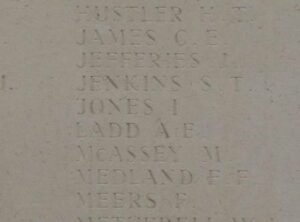
Isaac George Jones, Private, 29097, South Wales Borderers. Isaac was the son of William and Helen Jones, of Pontarddulais. He served with the South Wales Borderers, before being transferred to the 300th Reserve Company, Labour Corps. Isaac died on active service on 20 June 1917. He was 41 years old, and is buried in Pontarddulais (St. Teilo) Churchyard, Wales.
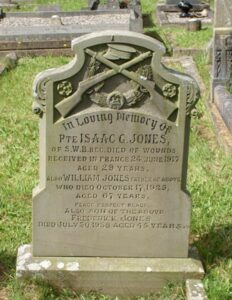
John Haydn Jones, Driver, 25807, Royal Engineers. John was born at Llandeilo Talybont, the son of James and Catherine Jones. His parents later resided at Brynarllwyn, Belgrave Road, Loughor. John enlisted at Llanelli into the Royal Engineers, and was posted to France on 7 October 1914 to join the 8th Signal Troop. He was killed in Flanders on 29 April 1915, aged 19. John is buried in Hazebrouck Communal Cemetery, France.
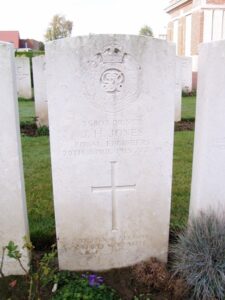
Matthew George Jones, Trimmer, 2677ST, Royal Navy. Matthew was born on 24 February 1897, the son of Thomas and Elizabeth Jones, of Harddfan Harleyford Road, Hendy. He was one of two men from Hendy who served in the Royal Navy aboard HMPMS Ascot, the first Paddle Minesweeper to be built for the Royal Navy. On 10 November 1918 Ascot was on minesweeping duties off the Farne Islands when she was torpedoed and sunk by the German submarine UB67. Ascot became the last Royal Naval ship to be lost during the Great War. Matthew was 21 years old when he died during the sinking, and is commemorated on Panel 29 of the Plymouth Naval Memorial, Devon.
Richard Alun Jones, Second Lieutenant, Tank Corps. Richard was the son of Reverend Griffith and Catherine Jones, of Capel Newydd, Hendy, Pontarddulais. He initially volunteered to serve with the Montgomeryshire Yeomanry, before being commissioned on 6 March 1917 into the Heavy Branch, Machine Gun Corps. On 28 July 1917 the Heavy Branch was separated from the rest of the Machine Gun Corps to form the Tank Corps. The newly formed Corps saw action during the Battle of Passchendaele, where the tanks proved incapable of moving across the sodden ground. The tank would prove its worth towards the end of the year, when they were used en masse to break the Hindenburg Line, during the Battle of Cambrai. Richard was in command of Tank D41 ‘Demon II’, part of ‘D’ Battalion, Tank Corps. On 20 November 1917, ‘D’ Battalion was attacking toward Flesquières when a shell made a direct hit on D41, instantly killing all her crew. Richard was 20 years old, and was buried in Flesquières Hill British Cemetery, France, in Grave VIII. E. 10. His brother Griffith was lost at sea in 1918. The fascinating fact about this is that a Tank has recently been recovered off the Flesquières Battlefield, which was at first thought to be D41. The tank has since been identified as D47, and is now on display in Flesquières.
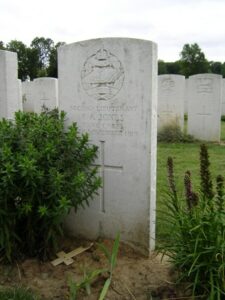
William Jones, Private, 53295, Cheshire Regiment. William was the son of William and Mary Jones of Felinfoel House, Coed Bach, Pontarddulais. He originally enlisted at Cardiff into the 2nd Battalion, Welsh Regiment on 14 July 1899, and had served for about twelve years with the colours prior to being discharged to the army reserve in 1911, seeing active service in South Africa during the Boer War and in India. He rejoined the army after the outbreak of war and was posted to France in November 1914, joining the 2nd Battalion, Welsh Regiment. He served with the battalion until being posted to the 1st Welsh, serving in Salonika before being transferred to the 14th Welsh, which was in France attached to 114 Brigade, 38th (Welsh) Division. He came home on leave in September 1917 and when he went back to France was posted to the 11th Battalion, Cheshire Regiment, which was attached to 7 Brigade, 25th Division. The Division had been hit hard during the German offensive of 21 March 1918, before moving to Flanders on the night of 30 March, taking up positions at Ploegsteert again, where they received reinforcements, and rebuilt. This is when William joined his new unit. Unfortunately the Division was caught up in a fresh German offensive, and it was during the opening of the Battle of the Lys that William was killed on 8 April 1918. He was 42 years old, and is commemorated on the Ploegsteert Memorial, Belgium.
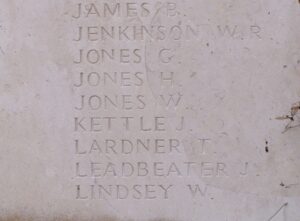
William John Jones, Private, 12754, Devonshire Regiment. William was the son of David and Mary Jones of Pontarddulais. He had enlisted at Swansea into the 2nd Battalion, Devonshire Regiment. At the outbreak of war the battalion was in Cairo, Egypt. It returned to England on 1 October 1914 and became attached to 23 Brigade, 8th Division, and landed in France on 6 November 1914. They saw their first major action at the Battle of Neuve Chapelle, and it was there that William was killed, on 11 March 1915. He was 19 years old, and is commemorated on the Le Touret Memorial, Richebourg L’Avoue, France.
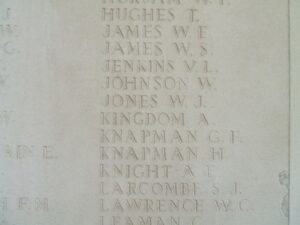
William Myrddin Jones, Sergeant, 1381, Welsh Regiment. William was born at Llandeilo-Talybont, the son of James and Elizabeth Jones. After his father’s death, the family moved to Enfield, Park Road, Gorseinon. William served with the 1/6th Battalion, Welsh Regiment, which was the Glamorgan Territorial battalion of the Welsh Regiment, and moved to France on 29 October 1914, moving to work on Lines of Communication near Calais. On 5 July 1915 the battalion moved to 84 Brigade, 28th Division, then on 23 October 1915 transferred to 3 Brigade, 1st Division, becoming the Divisional Pioneers. By the summer of 1916 the 1st Division was on the Somme, and it was there, on 29 August 1916, that William was killed. He was 23 years old, and is buried in Flatiron Copse Cemetery, Mametz, France. William is not commemorated on the Pontarddulais War Memorial.
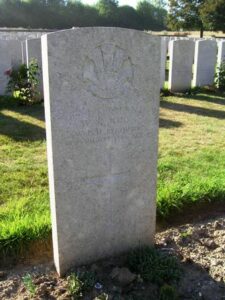
George William Kimber, Sapper, 256656, Royal Engineers. George was the son of John and Susan Kimber, of Caversham, Oxfordshire. George and his wife Florence Maud Kimber resided with his brother John Kimber at 10, Cambrian Place, Pontarddulais prior to the war, and George worked for the Great Western Railway. He enlisted at Reading into the Ox and Bucks Light Infantry, before transferring to the 264th Railway Company, Royal Engineers. George was wounded during the Battle of Passchendaele, and died of his wounds on 23 July 1917, aged 27. He is buried in Lijssenthoek Military Cemetery, Belgium.
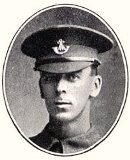
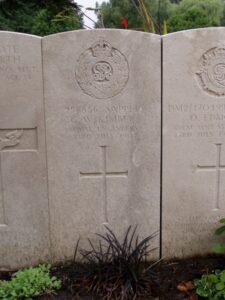
Thomas Lewis. This man cannot be positively identified, but is possibly John Thomas Lewis, Private, 184898, Machine Gun Corps. Thomas was born in 1899, the son of John and Sarah Lewis, of Ddolbren Forest, Pontarddulais. He enlisted at Carmarthen in October 1918 into the Training Battalion, Machine Gun Corps. Thomas was training at Rugeley when peace was declared, and he was demobilised from the army on 3 February 1919. Nothing further is known of him.
David Matthews, Private, 12963, Devonshire Regiment. David was the son of David and Ann Matthews, of Craif Fawr, Pontarddulais. He enlisted at Swansea into the 2nd Battalion, Devonshire Regiment. At the outbreak of war the battalion was in Cairo, Egypt. It returned to England on 1 October 1914 and became attached to 23 Brigade, 8th Division, and landed in France on 6 November 1914. They saw their first major action at the Battle of Neuve Chapelle, and then at the Battle of Aubers. They then saw further fighting at the Action of Bois Grenier, before moving to the Somme in 1916, where they fought at the Battle of Albert. David was killed on the first day of the Battle of Albert, on 1 July 1916. He was 26 years old, and is commemorated on the Thiepval Memorial, France.

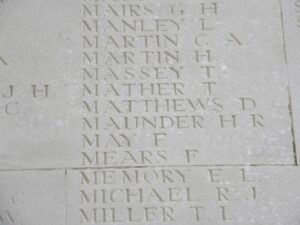
William McDonald, Private, 594, Connaught Rangers. William was born at Clifden, Co. Galway, and resided at Pontarddulais prior to the war. He enlisted at Llanelli into the army, joining the 5th Battalion, Connaught Rangers, which was attached to 29 Brigade, 10th (Irish) Division. On 27 June the Division received orders to prepare for service on Gallipoli, and embarked at Liverpool on 9 July. By the end of the month most units had assembled on Lemnos, and between 6 and 7 August 1915 landed on Gallipoli at Suvla Bay, less the 29th Brigade, which went to ANZAC Cove. The main body made an attack on Chocolate Hill on 7 and 8 August. Parts of 29th Brigade took part in actions on Sari Bair between 6 and 10 August, and Hill 60 later that month, and it was here that William was killed on 23 August 1915. He is commemorated on the Helles Memorial, Gallipoli.
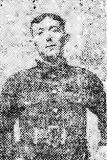
David Llewellyn Morgan, Private, 50300, Welsh Regiment. David was the son of John and Margaret Morgan, of Thistle Villa, Alltiago Road, Pontarddulais. He enlisted at Cardiff into the 2nd Battalion, Welsh Regiment. The 2nd Welsh was moved to France at the outbreak of war, attached to 3 Brigade, 1st Division, and took part in the retreat from Mons to the Marne, before moving to Ypres, where they fought at First and Second Ypres. The following year saw them in action again at the Battle of Aubers, before moving South to Loos, where they fought during the Battle of Loos, and the action at the Hohenzollern redoubt. Again they were required for a major offensive, moving south to the Somme, where they fought during the opening of the Somme Offensive at the Battle of Albert, then at Bazentin, Pozieres, Flers-Courcelette and Morval. They followed the German retreat to the Hindenburg Line in early 1917, and were then briefed for an operation on the Flanders Coast, and moved there during the summer of 1917. While training on the coast, the Battle of Third Ypres had stalled in the mire, and the Division were recalled to Ypres, where they fought at the Second Battle of Passchendaele. David was killed at Passchendaele on 9 November 1917, aged 24. He is commemorated on the Tyne Cot Memorial, Belgium.
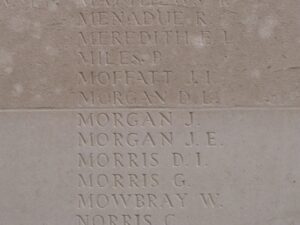
George Mayberry Morgan, Gunner, 95069, Royal Field Artillery. George was born in Middlesex in 1895, the son of Enoch Mayberry Morgan and Bertha Morgan. His father had served in the army for several years prior to becoming a Policeman, and the family later moved to the Police Station, Maentwrog, Merionethshire. George was residing at Pontarddulais prior to the war, and enlisted at Llanelli into the Royal Field Artillery. He was posted to France, landing on 1 June 1915, and joined B Battery, 63rd Brigade, RFA, which was attached to the 12th (Eastern) Division. George fought with the Division at Loos in September that year, and the following year fought at the Somme. In 1917 the Division fought at Arras and Cambrai, and returned to the Somme in 1918 where it again saw much fighting. On 4 September 1918 the Division relieved 18th (Eastern) Division east of the Canal du Nord and just south of Manancourt, for an attack on Nurlu, and it was here that George was killed on 5 September 1918. He was 23 years old, and is buried in Sailly-Saillisel British Cemetery, France.
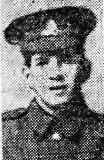
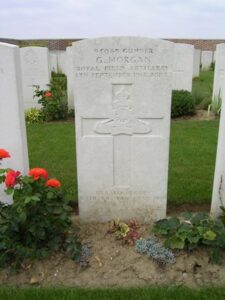
William Morris, Corporal, 20749, Welsh Regiment. William was born at Rhosamman, the son of Jonah and Margaret Morris. By 1911 he was living at Gwilym Road, Cwmllynfell with his wife Sarah Anne Morris and their two young girls. He then worked as a Cobbler at Pontarddulais prior to the war. He enlisted at Ammanford into the 15th Battalion, Welsh Regiment, which was known as the Carmarthen Pals, and was attached to 114 Brigade, 38th (Welsh) Division. The Division crossed to France in December 1915, and moved to Fleurbaix for trench initiation. In June 1916 the Welsh marched to the Somme, and took part in the attack on Mametz Wood. After capturing Mametz Wood, the Welsh Division was posted to positions north of Ypres, at Boesinghe, where it was to remain for the coming twelve months. William was wounded at Boesinghe, and died of his wounds on 27 February 1917, aged 28. He is buried in grave II.B.5. in Mendinghem Military Cemetery, Belgium.
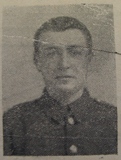
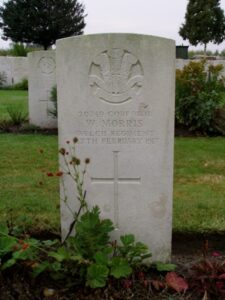
David John Owen, Private, 7606, Devonshire Regiment. David was the son of Mrs. Harris, of Arasfan, Loughor Road, Pontarddulais. He enlisted at Swansea into the 2nd Battalion, Devonshire Regiment, which moved to France on 6 November 1914 attached to 23 Brigade, 8th Division. They saw their first major action at the Battle of Neuve Chapelle, and then at the Battle of Aubers. They then saw further fighting at the Action of Bois Grenier, before moving to the Somme in 1916, where they fought at the Battle of Albert. David was killed on the Somme on 18 July 1916. He was 24 years old, and is commemorated on the Loos Memorial, France.
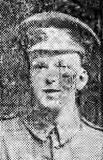
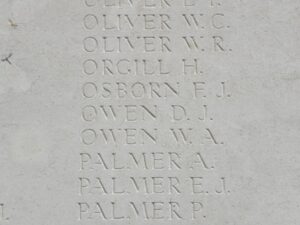
George Palmer, Driver, 92455, Royal Field Artillery. George was the son of William and Mary Palmer, of 1, Green Terrace, Hendy, and enlisted at Swansea into the Royal Field Artillery. He was posted to ‘B’ Battery, 69th Brigade, which was attached to the 13th (Western) Division. Towards the end of February the entire Division concentrated at Blackdown in Hampshire. On 7 June 1915 orders were received to prepare to move to the Mediterranean. On 13 June 1915 the first transports carrying the Division left port, and moved to Alexandria. By 4 July, all units had moved to Mudros, preparatory for landing on Gallipoli. Between 6 and 16 July 1915 the Divisional infantry landed on Cape Helles and relieved the 29th Division. George was killed soon after landing, on 26 July 1915. He was 20 years old, and is buried in Ari Burnu Cemetery, ANZAC, Gallipoli.
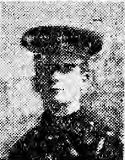
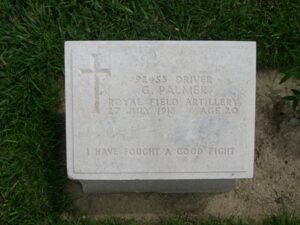
William John Parry, Gunner, 254, Royal Garrison Artillery. William was born at Tonna on 23 August 1894, the son of Thomas and Hannah Parry, of 9, New Road, Cilfrew. He was a Tinworker at Pontarddulais prior to the war, living with his brother Thomas David Parry at 12 Cambrian Place by 1914 and attended Tabernacle Baptist Church. William enlisted on 29 May 1915 into the Royal Garrison Artillery, and spent seven weeks in hospital after being kicked by a horse while training at Woolwich. He went to France on 30 March 1916, and joined the 2nd Brigade Ammunition Column. William was not at the front long, as he was wounded in action on 3 April 1916, and died of his wounds on 27 April 1916, aged 21. He is buried in Merville Communal Cemetery, France.
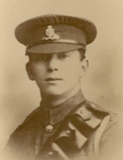
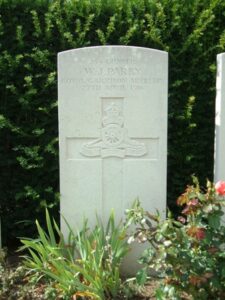
Charles William Morris Perks, Private, 200924, Welsh Regiment. William was the son of Charles Rees Perks and Elizabeth Perks, of Llandeilo. He married Blodwen Ethel Anthony, of 1, Pleasant Villas, Glynhir, Pontarddulais while on leave in 1916. William enlisted at Llandeilo into the 1/4th Battalion, Welsh Regiment. On 17 April 1915 it was attached to 159 Brigade, 53rd Division, and in July 1915, was shipped to Egypt, prior to landing at Suvla, Gallipoli on 8 August 1915. They remained here throughout a terrible campaign, which resulted in one stage of the Battalion being temporarily merged with the 1/5th Welsh due to the awful casualties suffered by both. In December, 1915 they were evacuated to Egypt, where the rebuilding of the Battalions began. The Division remained in Egypt until early 1917, guarding the Suez Canal. Early in 1917 the Division invaded Palestine, and fought through the three Battles of Gaza, and moved towards Jerusalem, where William was Killed in Action on 3 November 1917, aged 23. He is buried in Beersheba War Cemetery, Israel.
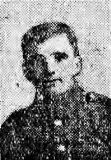
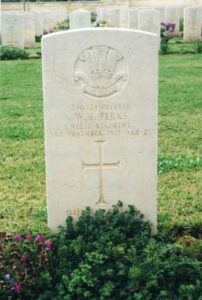
Bamford Peters, Private, 47331, Royal Welsh Fusiliers. Bamford was born at Briton Ferry in 1874, the son of James and Sarah Peters. By 1905 he was living with his wife Charlotte Peters, and their son Bamford,, at 11 Cambrian Place Pontarddulais, and by the start of the war the couple had moved to 2, Toll-Gate House, Hendy, Pontarddulais. Bamford had originally served with the 17th Battalion, Welsh Regiment, but was later transferred into the 4th Garrison Battalion, Royal Welsh Fusiliers, probably due to his age. Bamford died in France on 10 March 1917. He was 42 years old, and is buried in Ste. Marie Cemetery, Le Havre, France. Bamford is not commemorated at Pontarddulais.
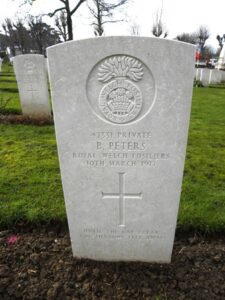
David Emrys Peters, Gunner, 114164, Royal Garrison Artillery. David was the son of Isaac and Elizabeth Peters, of 4, Coedsaeson Crescent, Sketty, and the husband of Elizabeth Peters of Pontarddulais. He enlisted at Swansea into the Royal Garrison Artillery, and was posted to France to join the 185th Siege Battery. David was killed during the build up to the Battle of Passchendaele on 5 July 1916. He was 29 years old, and is buried in Vlamertinghe New Military Cemetery, Belgium.
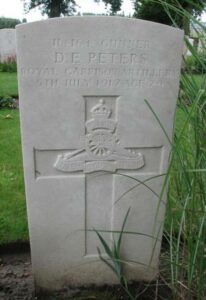
Thomas Henry Phillips, Gunner, 3187, Royal Field Artillery. Thomas was the son of William and Mary Phillips, of Bryngwili Road, Hendy. He married Annie Williams on 11 April 1914, and the couple had a son, William David Phillips. Thomas worked as a miner at the Graigola Colliery, and enlisted at Pontypridd into the Royal Field Artillery. He was posted to the 122nd Brigade, Royal Field Artillery, which was attached to the 38th (Welsh) Division. The Division had landed in France during December 1915 and had spent their first winter in the trenches near Armentieres. In June they marched south to the Somme, where they were tasked with the capture of Mametz Wood. The attack on the wood began on 7 July, but met with fierce resistance, and it took until 14 July to totally clear the wood. The Division suffered terrible casualties at Mametz, and were taken out of the line, and moved to Ypres to rebuild. Here they fought at the Battle of Pilckem Ridge, and it was here that Thomas was wounded during the opening day of the Battle, on 31 July 1917. He died later that day of his wounds, aged 23, and is buried in Dozinghem Military Cemetery, Belgium, in Grave II.H.16.
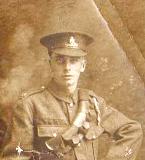
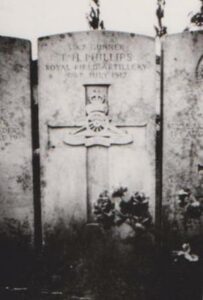
James Price, Stoker, 2678ST, Royal Naval Reserve. William was born on 27 February 1897, the son of John and Eleanor Price, of Harleyford Road, Hendy. He served in the Royal Navy, as one of two men from Llanedy, aboard HMPMS Ascot, the first Paddle Minesweeper to be built for the Royal Navy. On 10 November 1918 Ascot was on minesweeping duties off the Farne Islands when she was torpedoed and sunk by the German submarine UB67. Ascot became the last Royal Naval ship to be lost during the Great War. James was 21 years old when he died during the sinking, and is commemorated on Panel 29 of the Plymouth Naval Memorial, Devon.
Frederick Purchase, Private, 13039, Oxford & Bucks Light Infantry. Frederick was born at Weymouth, Dorset in 1886, and was the Husband of Hannah Purchase, of 3, Grove Terrace, Glanyravon Road, Pontarddulais. He enlisted at Swansea into the army, and was posted to the 7th Battalion, Oxford & Bucks Light Infantry, which was attached to 78 Brigade, 26th Division. On 21 September 1915 the battalion landed at Boulogne, but moved to Salonika in November 1915. Frederick was killed in Salonika on 17 August 1918. He was 33 years old, and is buried in Karasouli Military Cemetery, Greece.
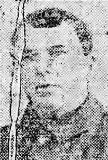
Walter Rees, Private, 1457, Welsh Guards. Walter was the son of David and Ann Rees, of 4, Bryn Row, Pontarddulais. He was married and resided at Haverfordwest prior to the war. He served with the 1st Battalion, Welsh Guards, which was attached to the 3rd Guards Brigade, Guards Division. This Division has the distinction of being formed in France in August 1915. The various Guards units that had been with other Divisions were withdrawn to be brought together to create this fine formation. It remained on the Western Front throughout the war and saw its first major action during the Battle of Loos on 25 September 1915, remaining in the area during the coming months, where they also fought in the subsequent Action of Hohenzollern Redoubt. In July, 1916 the Division moved to the Somme, where they fought at the Battle of Flers-Courcelette, and then at the Battle of Morval, capturing Lesboeufs Village. Walter was wounded at Flers, and evacuated to the Base Hospital at Boulogne, where he died of his wounds on 6 August 1916, aged 36. Walter is buried there, at Boulogne Eastern Cemetery, France.
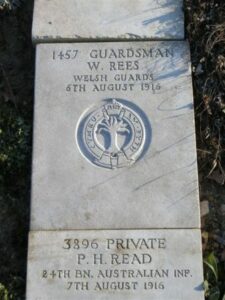
David Richards, Corporal, 25551, Welsh Regiment. David was born at Mardy, and resided at 2 Bridge Street, Pontarddulais prior to the war. He married Elizabeth Anne John of 23 Hope Street, Pontarddulais in 1910, and the couple had four children, Mary Hannah, Morwen, Annie and Glyn. David served with the 19th Battalion, Welsh Regiment, which was known as the Glamorgan Pioneers, and was attached to the 38th (Welsh) Division. The Division landed in France in December 1915, moving to the Nursery Sector near Fleurbaix. After several months training and gaining experience in this quieter sector, the Division moved to the Somme in June 1916, taking part in the capture of Mametz Wood, before being relieved and moving to Ypres. Here the Welshmen were posted to the Boesinghe sector, where they prepared for their part in the forthcoming Third Battle of Ypres. David was killed in action during the build up to the offensive, on 28 July 1917. He was 27 years old, and is buried in Bard Cottage Cemetery, Belgium. Many thanks to Martin Thomas for helping to identify David.
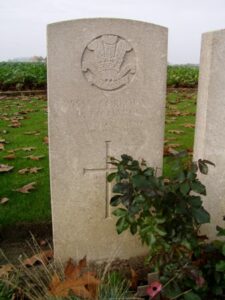
Benjamin Richardson, Private, G/63802, Middlesex Regiment. Benjamin was the son of Mrs. Isabella A. Roberts, of 171, Howard Street, Iffley Road, Oxford. He resided at Pontarddulais prior to the war. Benjamin enlisted at Cardiff into the Oxford & Bucks Light Infantry, and was transferred to the 19th Battalion, Middlesex Regiment, which was attached to 41st Division as Pioneer Battalion, which moved to France on 2 May 1916. In November 1917 the Division moved to Italy but returned to France in March 1918. It then faced the German Spring Offensive of 21 March 1918, and saw heavy fighting over the coming days, before being withdrawn, and sent north to Flanders where it held a sector near Ypres that was, for once, relatively quiet. Benjamin was killed in France on 22 August 1918. He was 22 years old, and is commemorated on the Vis-En-Artois Memorial, France.
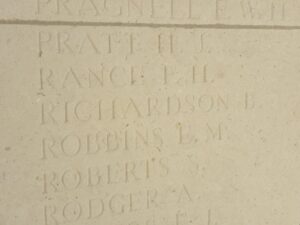
Bertie Roberts, Private, 401105, Manchester Regiment. Bertie was born at Pontarddulais. He resided at Bootle, Lancashire prior to the war, but returned to Swansea to enlist into the South Wales Borderers. Bertie was transferred to the 1/6th Battalion, Manchester Regiment in 1918, which was attached to 127 Brigade, 42nd (East Lancashire) Division. The Division had faced the German Spring Offensive on the Somme from 21 March 1918, and suffered heavy casualties. The offensive stalled for several months, until an Australian victory at Villers Brettoneux on 8 August saw the tide of war turn. The British attacked the German lines on the Somme on 21 August, with the 42nd Division in the line, and began the great offensive that was eventually to end the war. Bertie was killed on 27 September 1918, and is buried in Ribecourt Road Cemetery, Trescault, France. Bertie is not commemorated on the Pontarddulais War Memorial.
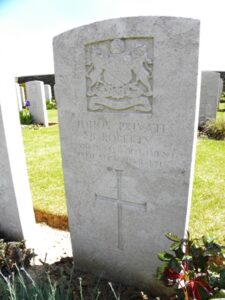
Richard Harry Sampson, Lieutenant, Welsh Regiment. Richard was the son of Richard Harry and Eliza Louisa Sampson, of Pontarddulais. He was commissioned on 23 June 1915 and was posted to the 15th Battalion, Welsh Regiment on 23 July 1916, joining the battalion after they had taken part in the attack on Mametz Wood, where it was attached to 114 Brigade, 38th (Welsh) Division. He then fought with the battalion during the following twelve months at Ypres, and saw action at Pilckem Ridge. On 26 February 1918 he was posted to the Headquarters Staff of the 38th Division, and sadly became ill during the final weeks of the war, dying of pneumonia at the Base Hospital at Étaples on 29 October 1918, aged 27. Richard is buried in Étaples Military Cemetery, France, in Grave XLVIII. C. 5.
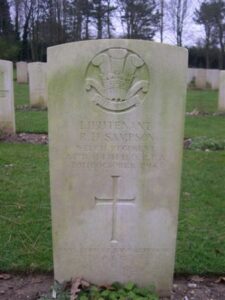
Ezzeline Samuel, Nurse, British Red Cross. Ezzeline was the daughter of Thomas and Lucy Samuel, of 31 Glynllwchwr Road, Pontarddulais. She served during the war as a nurse in the Red Cross Hospital at Brighton. Ezzeline died of influenza at Brighton in February 1919 aged 24. Nothing more is known of her, but six brothers and a sister also served and returned home safely. She is not commemorated on the Pontarddulais memorial.
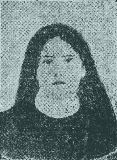
Charles Sandford, Private, 37826, Gloucestershire Regiment. Charles cannot be positively identified, as no-one of this name can be linked to Pontarddulais, but he may be this man. Charles was the son of Thomas and Elizabeth Sandford, of 4, Providence Place, Tewkesbury. He was a watchmaker prior to the war and enlisted at Gloucester into the Gloucester Regiment. He was later posted to France in 1916, joining the 12th (Bristol) Battalion, Gloucester Regiment, which was attached to 95 Brigade, 5th Division. March 1916 saw the Division moving to positions between St. Laurent-Blangy and Vimy, near Arras, and the Division saw plenty of action during its spell here. On 1 July 1916 the Battle of the Somme opened, and the Division moved south fighting at High Wood, Guillemont, Flers-Courcelette, Morval and Le Transloy. On 5 October, after suffering heavy casualties, the Division moved to Festubert, where it remained until March 1917. It next saw action at the Battle of Arras, fighting at the Battle of Vimy in April 1917, and the attack on La Coulette. Charles was killed at Arras on 22 April 1917, aged 26. He has no known grave, and is commemorated on the Arras Memorial, France.
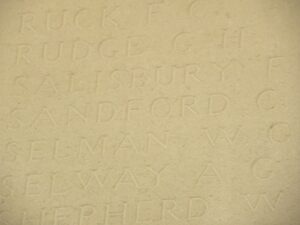
George William Sloper, Private, 17789, Welsh Regiment. George was the son of George and Laura Sloper, of 54, Ashley Down Road, Horfield, Bristol. He resided at Pontarddulais prior to the war, and enlisted at Swansea into the 14th Battalion, Welsh Regiment, which was known as the Swansea Pals. The battalion moved to France in December 1915 attached to 114 Brigade, 38th (Welsh) Division, and moved to positions at Fleurbaix. George was killed at Fleurbaix on 27 January 1916, aged 20. He is buried in St. Vaast Post Military Cemetery, Richebourg-L’Avoue, France.
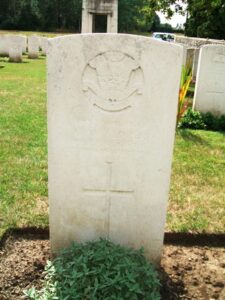
Edwin Edward Smith, Sergeant, 558038, Royal Engineers. Edwin was the son of George and Clara Smith, of 21, Moring Road, Tooting, London. Edwin worked with the GPO prior to enlist into the Royal Engineers in March 1914. At the outbreak of war Edwin was posted to the 29th Divisional Signal Company. The Division fought at Gallipoli, landing on 25 April 1915, and remained here until evacuation 11 January 1916. It moved to the Western Front on 15 March 1915, and saw its first major action in France during the 1916 Somme Offensive, and fought at the Battles of Albert and Le Transloy, suffering heavy casualties. In the Spring of 1917 they fought at the Battle of the Scarpe, which was part of the Arras Offensive, and then moved further north to Ypres. Here they fought at the Battle of Langemarck, and then at the Battles of the Menin Road, Polygon Wood, Broodseinde and Poelcappelle, before moving to Cambrai. Here they fought at the Battle of Cambrai in November and December 1917. Edwin was killed at Cambrai on 30 November 1917. He was 37 years old, and is buried in Gouzeaucourt New British Cemetery, France.
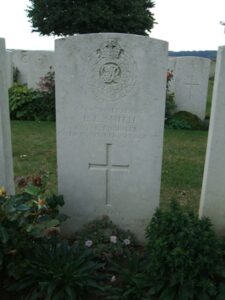
Joseph Henry Smith, Private, 12479, Somerset Light Infantry. Joseph was the son of Thomas and Sarah Smith, of Wem, Shropshire. He lodged with George Baylis at Pontarddulais prior to the war, working as a labourer. Joseph enlisted at Llanelli into the army, and was posted to the 1st Battalion, Somerset Light Infantry, which was attached to 11 Brigade, 4th Division. The division was one of the first to move to France, arriving just in time to join the hard-pressed Divisions of II Corps at The Battle of Le Cateau. They then took part in the epic retreat to the Marne, where the German Offensive was halted, and in the advance to the Aisne. The Division was then moved north to Flanders, and took part in the Battle of Messines, where Units of 4th Division took part in the famous Christmas Truce while they were still in this area, in trenches near Ploegsteert Wood. In 1915 the Division fought at the Second Battle of Ypres, and it was here that Joseph was killed on 11 June 1915, aged 28. He is commemorated on the Ypres (Menin Gate) Memorial, Belgium.

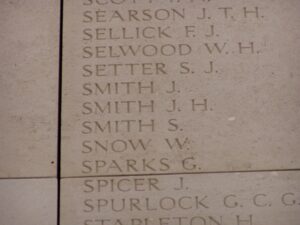
David Cuthbert Thomas, Second Lieutenant, Royal Welsh Fusiliers. David was the son of Reverend Evan and Ethelinda Thomas, of Llanedy Rectory, Pontarddulais. He was commissioned into the 3rd Battalion, Royal Welsh Fusiliers, and after training was posted to the 1st RWF, which was attached to 22 Brigade, 7th Division. By early 1916 the Division was in position at the Citadel, near Fricourt, on the Somme. On 18 March 1916, David was in charge of a working party, which was repairing wire emplacements in No Man’s Land when he was shot in the throat. He walked to the First Aid Post for treatment, but began choking and died shortly afterwards. He was 20 years old, and is buried in Point 110 New Military Cemetery, Fricourt, France, in Grave D. 3. David was a close friend of the famed war poets, Siegfried Sassoon and Robert Graves. His death left Sassoon especially very angry towards the Germans; an anger which led to his earning the Military Cross after a series of rash excursions into German territory. Robert Graves wrote a poem in memory of David, entitled ‘Not Dead’, and David is mentioned in several poems and biographies written by both men, under the pseudonym of Dick Tiltwood in one. It was largely David’s death that famously soured Sassoon’s attitude towards the war.
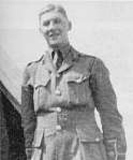
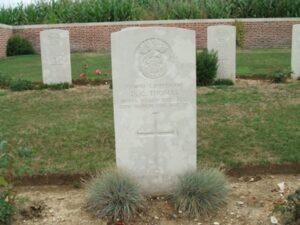
James Edward Stallard Thomas, Private, M/305649, Royal Army Service Corps. James was the son of David and Maria Martha Thomas, of Factory Road, Pontarddulais. He worked as a Blacksmiths Striker prior to the war, at the Post Office Telephone Factory at Pontarddulais. He enlisted on 6 June 1916 into the Army Service Corps, and remained on Home Service. James became ill, and died at the Military Hospital at Aldershot on 27 February 1918. He was 21 years old and is buried in Rhydgoch Cemetery, Wales.
Stanley Thomas, Private, 14716, South Lancashire Regiment. Stanley was the son of David and S. Thomas of 11, Cambrian Place, Pontarddulais. He enlisted at Swansea on 8 September 1914 into the South Lancashire Regiment, and was posted to France on 28 September 1915 with the 8th Battalion, South Lancashire Regiment, which was attached to 75 Brigade, 25th Division. The Division moved to the Vimy area, where they defended Vimy Ridge against a German attack in May 1916. They then moved to the Warloy area and attacked on 3 July near Thiepval, remaining on the Somme for the duration of the Battle of the Somme. Stanley was killed on the Somme on 1 October 1916. He was 19 years old and is commemorated on the Thiepval Memorial, France. There was some confusion after his death, as he was initially reported as wounded and missing, and was reported to have been in hospital in England. Stanley is not commemorated on the Pontarddulais memorial.


Thomas Edward Thomas, Rifleman, 9867, Rifle Brigade (The Prince Consort’s Own). Edward was born at Pontarddulais in 1883, and became a Tinworker before enlisting into the Rifle Brigade on 5 May 1903. He married Susannah Mary Hopkins, of 16, Charles Street, Briton Ferry, on 6 March 1909, and the couple had five children. Edward served from 1903 until the outbreak of the Great War, when he was serving in Ireland with the 3rd Battalion, Rifle Brigade, as part of 17 Brigade, 6th Division. On 12 September 1914 the Division landed at St. Nazaire, and moved to Flanders. Edward was killed just over a month after landing in France, on 23 October 1914. He was 31 years old, and is buried in Y Farm Military Cemetery, Bois-Grenier, France. Edward is not commemorated on the Pontarddulais memorial.
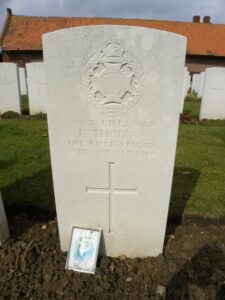
James Samuel Trow, Private, 612319, London Regiment. James was the son of James and Sarah Trow, of Pontarddulais. His father had died in 1893, and his mother remarried George William Lowe in 1899. James married Mary E. Owen at Pontypridd in 1915. He enlisted at Pentre into the Army, first serving with the King’s Royal Rifle Corps before being transferred into the 1/19th Battalion, London Regiment. The battalion was formed in August 1914 at 76 High Street, Camden Town., becoming part of 141 Brigade, 47th (2nd London) Division, and moved to France in March 1915. The Division fought at the Battles of Aubers, and Festubert during May 1915 and in September fought at the Battle of Loos. During the summer of 1916 the Division fought at the Battle of Flers-Courcelette, and then the Battle of Le Transloy, where the Division captured Eaucourt l’Abbe, and took part in Attacks on the Butte de Warlencourt. Early in 1917 the Division moved north to Belgium, and took part in the Battle of Messines, and then in November 1917 fought at the Battle of Cambrai. James was wounded at Cambrai, and died in hospital on 4 December 1917, aged 24. He is buried in Abbeville Communal Cemetery Extension, France. For information, the memorial names James Edward Trow.
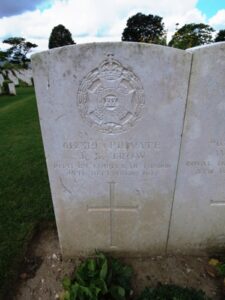
Frederick Wall, Sergeant, 52612, Cheshire Regiment. Frederick was the son of Charles and Mary Wall, of Much Wenlock, Shropshire. He married Rhoda Kate Archer at Bridgenorth in June 1903, before moving to 4, New Road, Grove End, Pontarddulais, where Frederick worked as a forester. Frederick enlisted there in February 1915 into the 15th Battalion, Welsh Regiment, which was the Carmarthen Pals battalion, and landed in France with the battalion on 2 December 1915. Frederick survived the fighting at Mametz Wood in July 1916, and in September was transferred into the 1/7th Battalion, Cheshire Regiment, which was attached to 102 Brigade, 34th Division. Frederick was killed during the Advance in Flanders, on 14 October 1918. He was 37 years old, and is buried in Hooge Crater Cemetery, Belgium. Rhoda died at Pontarddulais in 1968. Frederick is not commemorated locally.
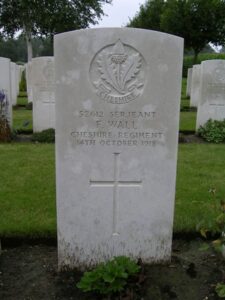
Albert Edward Ward, Private, 235597, Royal Welsh Fusiliers. Albert was the son of William and Sarah Ann Ward, of The Cottage, Pontarddulais. He married Florence Ellis in 1914, and the couple had two sons, William and Albert. Albert originally served with the South Wales Borderers, before being posted to the 17th Battalion, Royal Welsh Fusiliers, which was part of 115 Brigade, 38th (Welsh) Division. Albert probably joined the battalion on the Somme in 1918, and took part in the great advance over the old Somme battlefields. He was killed in action at the Forest of Mormal on 4 November 1918, aged 33, and is buried in Englefontaine British Cemetery, France.
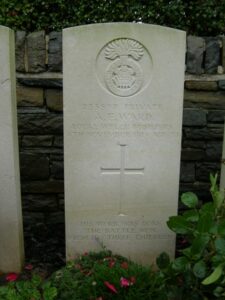
Charles Webb, Sapper, 125214, Royal Engineers. Charles was born in 1895. He worked as a Coalminer, and lived at 7, Cambrian Place, Pontarddulais with Emily Yelling (possibly Yelland). He enlisted into the Royal Engineers on 19 October 1915, and moved to France ten days later, joining the 11th Labour Battalion, Royal Engineers. Charles served on the Western Front until 25 January 1919, when he was demobbed and returned home. He was diagnosed with pulmonary tuberculosis soon after, and was awarded a pension of 40 shillings. Charles died in 1922, too late for commemoration by the CWGC.
James White. James was born in 1900, the son of Richard and Minnie White, of The Huts, Pontlliw. No more is presently known of him.
Albert Ernest Williams, Able Seaman, 218031, Royal Navy. Albert was born at Llangynog on 3 November 1884. Prior to the war he lived with his wife Helen Williams, at 5, Williams Street, Pontarddulais, Glamorgan. He served in the Royal Navy, aboard HMS Good Hope, which was attached to the West Indies Squadron. Albert was killed when Good Hope was sunk with all hands at the Battle of Coronel on 1 November 1914. He was 29 years old, and is commemorated on Panel 3 of the Portsmouth Naval Memorial, Hampshire.
David Daniel Williams, MM, Private, 12753, Devonshire Regiment. David was the son of Thomas and Margaret Williams, and the Brother of Mrs. Catherine Ann Hopkins, of 16, Dantwyn Road, Pontarddulais. He enlisted at Swansea into the 2nd Battalion, Devonshire Regiment, which was attached to 23 Brigade, 8th Division. The Division landed in France on 6 November 1914, and David joined it on 2 May 1915, arriving among a batch of reinforcements. David saw his first fighting at the Action of Bois Grenier, before the Division moved to the Somme in 1916, where they fought at the Battle of Albert. In March, 1917 they followed the German Retreat to the Hindenburg Line, and later that year moved to Ypres, fighting at the Battle of Pilckem, and the Battle of Langemarck. In March, 1918 the Division were on the southern end of the Somme, and here met the German Offensive head on, at the Battle of St Quentin. David was killed in the desperate attempt to stem the German advance on the Somme, on 25 March 1918. He was 26 years old, and is commemorated on the Pozieres Memorial, France. David had been awarded the Military Medal for Bravery in the Field during his time at war.
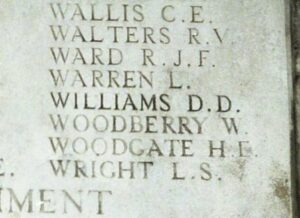
Ivor Carlyle Williams, Private, 66193, Cheshire Regiment. Ivor had been born at Milford Haven, the son of John and Eleanor Williams. By 1911 the family had moved to 11, William’s Street, Pontarddulais. Ivor enlisted at Swansea on 12 June 1915 into the 15th Battalion, Welsh Regiment, which was known as the Carmarthen Pals Battalion. On 5 October 1915 he was discharged after being found to be under age, but re-enlisted on 14 February 1917. Ivor was posted to France during the spring of 1918, joining the 9th Battalion, Cheshire Regiment, which was attached to 56 Brigade, 19th (Western) Division. In 1918 the division was caught up in the German Spring Offensive near St. Quentin, where they suffered terrible casualties, and fought at the Battle of Bapaume. They moved to Ypres, but were caught up in the German attack at Messines. Ivor was wounded at Messines, and died of his wounds on 29 April 1918. He was 19 years old, and is buried in Esquelbecq Military Cemetery, France, in Grave I. B. 27.
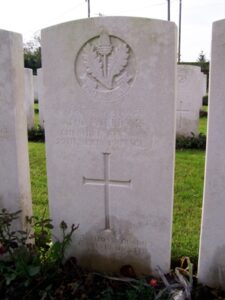
Oswald Williams, Ordinary Seaman, Z/5339, Royal Naval Volunteer Reserve. Oswald was born at Cray, Breconshire on 11 January 1900, the son of Thomas and Anne Williams. At some time after 1911 the family had moved to Penny Bank, Craigfawr, Pontarddulais. Oswald enlisted into the Royal Navy, and was based at the R.N. Depot, Crystal Palace. He died from disease while undergoing training on 5 October 1918, aged 18, and is buried in Pontarddulais (Goppa) Calvinistic Methodist Chapelyard, Wales.
Thomas Jenkins Williams, Private, 14789, East Lancashire Regiment. Thomas was the son of Jenkin and Rebecca Williams, of Plas-Isaf, Waungron, Pontarddulais, and he enlisted at Swansea into the army. He was posted to France to join the 11th Battalion, East Lancashire Regiment, which was attached to 94 Brigade, 31st Division. During December 1915 the Division moved to Egypt, and took part in the defence of Suez Canal. In March, 1916 they moved to France, where they saw their major action at the Battle of Albert in July 1916, and fought in the Battle of the Ancre. It moved to Arras the following year, where it fought at the Third Battle of the Scarpe, and helped in the capture of Oppy Wood. At the beginning of 1918 the Division were in the St. Quentin sector. It was here that they were among the Divisions hit by the German Spring Offensive of 21 March 1918 at the Battle of St Quentin. The Division withdrew west, fighting at the First Battle of Bapaume, and then at the First Battle of Arras. After suffering terrible casualties the Division were moved to Flanders to rest, but in April the Germans launched an offensive in Flanders, and the Division were caught up in the fighting there, at the Battle of Estaires, and then at the Battle of Hazebrouck where they played a part in the Defence of Nieppe Forest. In August, 1918 the war turned in favour of the Allies, and the Division took part in the Advance in Flanders. Thomas was killed in Flanders on 12 September 1918, aged 30. He is buried in Pont-D’Achelles Military Cemetery, Nieppe, France. Photograph of Thomas courtesy of Martin Thomas.
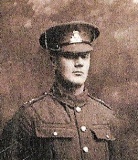
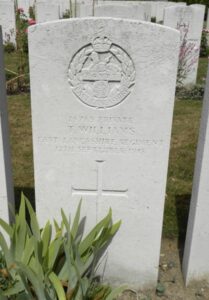
Trevor Lewis Williams, Lieutenant, Royal Air Force. Trevor was the son of Thomas and Margaret Williams, of Ynys House, Pontarddulais, and served with 72 Squadron, Royal Air Force. Number 72 Squadron formed at Netheravon on 2 July 1917 from a nucleus provided by the Central Flying School and embarked for the Middle East on Christmas Day, re-grouping in Basra on 2 March 1918. Here, the unit operated as self-contained Flights allotted to individual Army Corps using Bristol M1c Bullets, Spad VIIs, Martinsyde G100s and SE5s to carry out the various tasks required. Trevor was killed in Persia on 1 January 1919, aged 21, and is buried in Baghdad (North Gate) War Cemetery, Iraq.